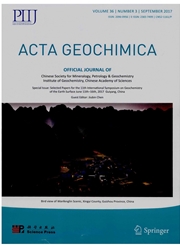

 中文摘要:
中文摘要:
锑是近年来受到普遍关注的有害微量元素,广泛的存在于环境中。煤炭的开采利用向环境中释放的锑成为煤矿区环境中锑的重要污染源。矿区承载了煤的开采堆放加工等诸多活动.然而锑在煤矿区的分布及其相关的环境效应至今报道较少。本文以安徽淮北芦岭矿区为研究对象.共收集38个表层土壤样和塌陷湖及周边水体水样。通过分析得出:锑在土样中的平均浓度为4.5×10^-6,矸石堆放和煤的洗选是矿区土壤中锑的重要来源,已形成轻度污染。锑主要与土壤中固定相结合,但矿区的强氧化环境和酸性废水会加速矿物中锑的释放;三个塌陷湖和背景水体中锑的平均浓度分别为1.3×10^-9和0.7×10^-9,主要来源于矿区的人为活动.但尚未在水深40~60cm处形成富集,基于多个饮用水标准.评价其仍可作为矿区的生活和饮用水源。
 英文摘要:
英文摘要:
Antimony(Sb) has been paid more and more attention recently because of its potential toxicity in environment. Usage of coal plays an important role in release of Sb. During mining, combustion and other utilization processing of coal, Sb is prone to volatilize into atmosphere and enrich in different residue, especially in coal mine field while the investigation on which is scarce. In this paper, we look into Luling coal mine in Huaibei of Anhui and collect 38 samples of surface soil and water. The surface soil is polluted with the average content of Sb is 4.5 ×10^-6 which is mainly caused by the deposition of coal parting and coal cleaning process. But the release maybe accelerated due to the increased oxidation rates and acid mine drainage; mean content of Sb in slumping water is 1.3×10^-9 which show slight pollution comparing with 0.7 ×10^-9 of Sb in flowing creek water. It's concluded that slumping water in Luling mine is secure for everyday living and drinking purpose.
 同期刊论文项目
同期刊论文项目
 同项目期刊论文
同项目期刊论文
 Abundances of Polycyclic Aromatic Hydrocarbons (PAHs) in 14 Chinese and American Coals and Their Rel
Abundances of Polycyclic Aromatic Hydrocarbons (PAHs) in 14 Chinese and American Coals and Their Rel Geochemistry of environmentally sensitive trace elements in Permian coals from the Huainan coalfield
Geochemistry of environmentally sensitive trace elements in Permian coals from the Huainan coalfield Characteristics of coal quality and their relationship with coal-forming environment: A case study f
Characteristics of coal quality and their relationship with coal-forming environment: A case study f Antimony, arsenic and mercury in the aquatic environment and fish in a large antimony mining area in
Antimony, arsenic and mercury in the aquatic environment and fish in a large antimony mining area in Capillary electrophoresis profiles and fluorophore components of humic acids in Nebraska corn and Ph
Capillary electrophoresis profiles and fluorophore components of humic acids in Nebraska corn and Ph Antimony speciation and contamination of waters in the Xikuangshan antimony mining and smelting area
Antimony speciation and contamination of waters in the Xikuangshan antimony mining and smelting area Characterization of Nanming River (southwestern China) sewerage-impacted pollution using an excitati
Characterization of Nanming River (southwestern China) sewerage-impacted pollution using an excitati Vertical Distributions of Plutonium and 137Cs in Lacustrine Sediments in Northwestern China: Quantif
Vertical Distributions of Plutonium and 137Cs in Lacustrine Sediments in Northwestern China: Quantif Characteristics and distribution of low molecular weight organic acids in the sediment porewaters in
Characteristics and distribution of low molecular weight organic acids in the sediment porewaters in Vertical distributions of 239+ 240 Pu activity and 240 Pu/239 Pu atom ratio in sediment core of Lake
Vertical distributions of 239+ 240 Pu activity and 240 Pu/239 Pu atom ratio in sediment core of Lake Determination of plutonium isotopes in freshwater lake sediments by sector-field ICP-MS after separa
Determination of plutonium isotopes in freshwater lake sediments by sector-field ICP-MS after separa Phosphorus Composition in Sediments from Seven Different Trophic Lakes, China: A Phosphorus-31 NMR S
Phosphorus Composition in Sediments from Seven Different Trophic Lakes, China: A Phosphorus-31 NMR S 期刊信息
期刊信息
